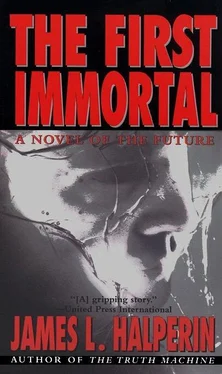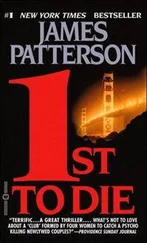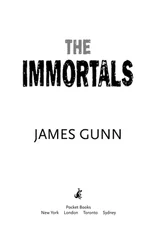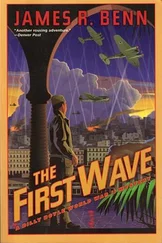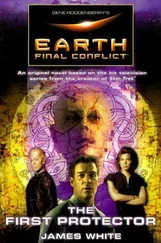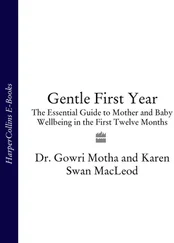I told myself I was still occupied helping others revive their loved ones; a plate to satisfy any such hunger.
May 13, 2066
—Dexinol, a variant of Deximine, Merck’s popular protein-based anesthetic, is approved by the WDA as a hibernation drug. By keeping a supply in their abdominal medicine pumps, people can direct their pharmaceutical AIs to induce sleep for exact, predetermined periods of time. “We expect Dexinol to be especially popular among men whose wives insist upon being accompanied to the ballet,” a company spokesman deadpans.—Renowned Kiev archivist Stanislaw Kravitz discovers records contradicting previous theories about the purported suicide of Martin Bormann. The records confirm that Adolf Hitler’s Dark Angel, disguised as a German Unterschaführer of the Waffen SS, was captured on May 3, 1945, by the withdrawing Russo-Ukranian Fourth Red Brigade. Further photographic evidence sifted by newly alerted AIs conclude a 121-year-old mystery by proving that Bormann died of consumption in the Arctic Gulag on February 17, 1958.—Latest Planetary Economic Bureau figures show that Virtual Reality providers now receive a record 76-percent share of all advertising revenues. Including user fees, VR now constitutes an astonishing 14.1 percent of Gross World Product. “Human attention is by far the most valuable commodity on Earth,” explains J. Walter Thompson Agency CEO James Patterson Jr. “And VR has proven by far the most effective way to get it!”
The DNA-copying mechanisms in some human cells make less than one misprint every 100 billion nucleotide replications. But by 2066 the disassembler/assemblers were already far more accurate than their human counterparts. Redundant systems checked themselves and each other for defects. Design diversity allowed their on-board and central AIs to examine any borderline cases from multiple perspectives. And the D/A’s proofread their repair work in teams, with each individual D/A at least ten times more accurate than any human replicator. Therefore the odds that the machines would allow even a single error during the DNA overhaul of a human being were under one in fifty billion.
DNA was the easy part; memory recovery would be another story.
In February 2066, 171 former death-row prisoners who’d volunteered for biostasis experiments had become the first humans to be revived from cryonic suspension. These subjects had been frozen under perfect postdeath conditions: Their executions had been scheduled.
The first group of seventy-one prisoners, those whose offenses had been the most egregious, had all been revived as young, perfectly healthy partial amnesiacs.
The second group of one hundred was more fortunate. All but seven very early, nonvitrified subjects were brought back with fully preserved identity and memories.
In spite of a halfhearted objection from the WCLU—formerly ACLU—their criminal proclivities were also simultaneously removed.
Virginia Gonzalez remembered the ski lodge, the crackling faux fire in their chamber, and the ceramic walls made to look like the inside of a log cabin: all the comforts of environmental manipulation, all the charm of roughing it. She remembered making love with Alica and thinking that they both seemed to be getting better at it as they aged. Afterward they could hardly wait to get out onto the powder. But maybe she’d been drained from the sex, because next came those bizarre dreams. Had she fallen asleep? She hoped it was still daylight. What if she’d squandered the whole afternoon’s skiing for a nap?
She opened her eyes and saw Alica, her Alica, but somehow different—younger, maybe? Yes. Definitely younger-looking—and wearing a peculiar smile. The room was white and sterile and small; not at all as she remembered their chamber by the slopes.
She heard Alica’s words: “Welcome back, my love.”
“B-Back? From where?”
“You had an accident. But you’re fine now, better than new. It was a long time ago.”
“How l-long ago?” Virginia’s entire body shuddered. “Today is May thirteenth.” Alica Banks perched at the side of the recovery clinic pod, stroking the neuroscientist’s now-unwrinkled hand, gazing at her face. “May thirteenth, 2066.”
Her lover’s prolonged silence warned Alica that this was no time to disclose the existence of a husband whom Virginia had never met, now part of their family.
Alica had once dreaded telling Caleb that she intended to revive her long-suspended spouse. But they all shared a daughter now, and Virginia would soon learn that Alica and Caleb also had a six-year-old son. Perhaps Virginia would grow to adore Devon as much as Caleb now cherished his stepdaughter, Lysa. Maybe her two spouses would even fall in love with each other. Alica wasn’t quite sure how she felt about that. The sex arrangements might be tricky. Jealousies would surface. Repressing the green-eyed monster would be pointless, especially in the era of the Truth Machine. Of course, unrepressed jealousy was a lot less dangerous than the festering stuff. Furthermore, Alica had no intention of giving up either partner. And if Virginia and Caleb decided to experiment with each other, well, fair was fair.
“I knew it had to happen sooner or later,” Caleb had said. “It’s not like you didn’t warn me. I just expected the technology to come later instead of sooner, y’know?” But he hadn’t tried to talk her out of it, especially since, with Lysa graduating in June, the timing had been inarguably opportune.
No one had spoken for nearly half an hour. Alica waited.
“You look… good,” Virginia finally managed, propping herself up on the pod’s mattress, without even bothering with the voice-activated positioning device. “W-Wonderful, in fact. Y-Younger, too, right?” It was obvious that she remembered nothing of the accident, or the several hours before it. Alica had been warned that that was nearly always how it went: establish composure, then integrate facts.
Although scientists had known for a long time that short-term memory involved electrical activity and unstable biochemical changes. The brain’s ability to retrieve such memory had been overestimated by previous work. While cryonic suspension could safely preserve all long-term, “static” memory, anything that had occurred in the final hours before an accident, having had no time to harden into molecular information within neurons, would often vanish.
Alica knew that to a neuroscientist like Virginia, who’d been on ice for nine years and was unaware of this newly discovered phenomenon, such memory loss might be the most disconcerting part of the ordeal.
“Reflector screen,” Alica ordered to the environmental AI, illuminating the west wall of the cubicle with Virginia’s image. “Yes, and so do you. Look at yourself. You already appear twenty years younger than you did on the day of the accident, and within forty-eight hours you’ll have the body of a twenty-one-year-old woman.”
“H-How?”
“Nanorepaired DNA. More perfect than a newborn’s.”
Virginia stared at herself on the screen, barely believing the image. She still felt shaken and terribly disoriented. But her mishap did seem to have its compensations: When she discounted her psychological pain and focused on the physical, she realized she’d never felt better. For Virginia, this was a miracle contained within a single day. Perhaps the “lost” years, if that was how she chose to regard them, had no meaning. It was almost like awakening on another planet in a “fresh” body.
The wonder of it! Maybe the wonder of it could help her overlook that the world and the people she loved had gone on with their existence for nearly a decade, without her.
Besides, it was not her nature to burden others with her own insecurities. “My Lord, it’s incredible!” Now, only the tremble in her voice betrayed any anxiety. “I d-didn’t think they’d have this technology for decades. I fall asleep, and about a hundred years happens, in what? Nine?”
Читать дальше
